Ford RANGER-2005 User Manual
Table of Contents |
|
|
|
Introduction |
4 |
|
|
|
|
Instrument Cluster |
10 |
|
|
Warning and control lights |
10 |
Gauges |
14 |
|
|
Entertainment Systems |
16 |
|
|
AM/FM stereo |
16 |
AM/FM Stereo single CD/MP3 system |
18 |
AM/FM Stereo cassette, CD/MP3 sound system |
21 |
In-dash CD6/MP3 disc Premium/Audiophile Pioneer audio |
|
system |
25 |
Tremor IV CD/MP3 audio system |
28 |
|
|
Climate Controls |
34 |
|
|
Heater only |
34 |
Manual heating and air conditioning |
35 |
|
|
Lights |
37 |
|
|
Headlamps |
37 |
Turn signal control |
40 |
Bulb replacement |
41 |
|
|
Driver Controls |
47 |
|
|
Windshield wiper/washer control |
47 |
Steering wheel adjustment |
48 |
Power windows |
49 |
Mirrors |
50 |
Speed control |
50 |
|
|
Locks and Security |
56 |
|
|
Keys |
56 |
Locks |
56 |
1

Table of Contents
Seating and Safety Restraints |
60 |
|
|
Seating |
60 |
Safety restraints |
62 |
Air bags |
73 |
Child restraints |
82 |
|
|
Tires, Wheels and Loading |
95 |
|
|
Tire Information |
98 |
Tire Inflation |
99 |
Changing tires |
103 |
Lug Nut Torque |
110 |
Vehicle loading |
119 |
Trailer towing |
126 |
Recreational towing |
135 |
|
|
Driving |
137 |
|
|
Starting |
137 |
Brakes |
141 |
Transmission operation |
144 |
|
|
Roadside Emergencies |
159 |
|
|
Getting roadside assistance |
159 |
Hazard flasher switch |
160 |
Fuel pump shut-off switch |
160 |
Fuses and relays |
161 |
Jump starting |
171 |
Wrecker towing |
176 |
|
|
Customer Assistance |
177 |
|
|
Reporting safety defects (U.S. only) |
185 |
|
|
Cleaning |
186 |
|
|
2
|
Table of Contents |
|
|
Maintenance and Specifications |
193 |
|
|
Engine compartment |
195 |
Engine oil |
199 |
Battery |
205 |
Engine Coolant |
207 |
Fuel information |
214 |
Air filter(s) |
230 |
Part numbers |
231 |
Refill capacities |
232 |
Lubricant specifications |
235 |
|
|
Accessories |
243 |
|
|
|
|
Index |
246 |
|
|
All rights reserved. Reproduction by any means, electronic or mechanical including photocopying, recording or by any information storage and retrieval system or translation in whole or part is not permitted without written authorization from Ford Motor Company. Ford may change the contents without notice and without incurring obligation.
Copyright © 2004 Ford Motor Company
3
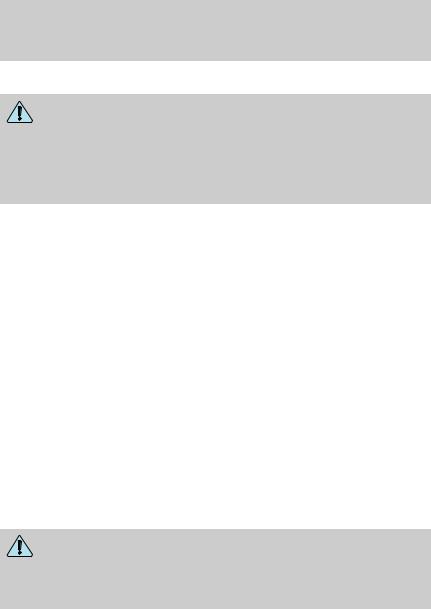
Introduction
CALIFORNIA Proposition 65 Warning
WARNING: Engine exhaust, some of its constituents, and certain vehicle components contain or emit chemicals known to
the State of California to cause cancer and birth defects or other reproductive harm. In addition, certain fluids contained in vehicles and certain products of component wear contain or emit chemicals known to the State of California to cause cancer and birth defects or other reproductive harm.
CONGRATULATIONS
Congratulations on acquiring your new Ford. Please take the time to get well acquainted with your vehicle by reading this handbook. The more you know and understand about your vehicle, the greater the safety and pleasure you will derive from driving it.
For more information on Ford Motor Company and its products visit the following website:
•In the United States: www.ford.com
•In Canada: www.ford.ca
•In Australia: www.ford.com.au
•In Mexico: www.ford.com.mx
Additional owner information is given in separate publications.
This Owner’s Guide describes every option and model variant available and therefore some of the items covered may not apply to your particular vehicle. Furthermore, due to printing cycles it may describe options before they are generally available.
Remember to pass on this Owner’s Guide when reselling the vehicle. It is an integral part of the vehicle.
Fuel pump shut-off switch: In the event of an accident the safety switch will automatically cut off the fuel supply to the
engine. The switch can also be activated through sudden vibration (e.g. collision when parking). To reset the switch, refer to the Fuel pump shut-off switch in the Roadside Emergencies chapter.
4
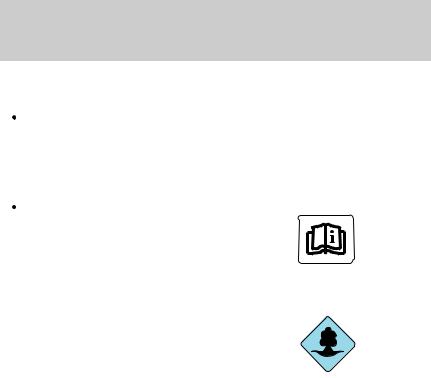
Introduction
SAFETY AND ENVIRONMENT PROTECTION
 Warning symbols in this guide
Warning symbols in this guide
How can you reduce the risk of personal injury to yourself or others? In this guide, answers to such questions are contained in comments highlighted by the warning triangle symbol. These comments should be read and observed.
 Warning symbols on your vehicle
Warning symbols on your vehicle
When you see this symbol, it is imperative that you consult the relevant section of this guide before touching or attempting adjustment of any kind.
Protecting the environment
We must all play our part in protecting the environment. Correct vehicle usage and the authorized disposal of waste, cleaning and lubrication materials are significant
steps towards this aim. Information in this respect is highlighted in this guide with the tree symbol.
BREAKING-IN YOUR VEHICLE
Your vehicle does not need an extensive break-in. Try not to drive continuously at the same speed for the first 1,000 miles (1,600 km) of new vehicle operation. Vary your speed frequently in order to give the moving parts a chance to break in.
Drive your new vehicle at least 500 miles (800 km) before towing a trailer.
Do not add friction modifier compounds or special break-in oils during the first few thousand miles (kilometers) of operation, since these additives may prevent piston ring seating. See Engine oil in the Maintenance and Specifications chapter for more information on oil usage.
5

Introduction
SPECIAL NOTICES
Emission warranty
The New Vehicle Limited Warranty includes Bumper-to-Bumper Coverage, Safety Restraint Coverage, Corrosion Coverage, and 6.0L Power Stroke Diesel Engine Coverage. In addition, your vehicle is eligible for Emissions Defect and Emissions Performance Warranties. For a detailed description of what is covered and what is not covered, refer to the Warranty Guide that is provided to you along with your Owner’s Guide.
Service Data Recording
Service data recorders in your vehicle are capable of collecting and storing diagnostic information about your vehicle. This potentially includes information about the performance or status of various systems and modules in the vehicle, such as engine, throttle, steering or brake systems. In order to properly diagnose and service your vehicle, Ford Motor Company, Ford of Canada, and service and repair facilities may access vehicle diagnostic information through a direct connection to your vehicle when diagnosing or servicing your vehicle.
Event Data Recording
Other modules in your vehicle — event data recorders — are capable of collecting and storing data during a crash or near crash event. The recorded information may assist in the investigation of such an event. The modules may record information about both the vehicle and the occupants, potentially including information such as:
•how various systems in your vehicle were operating;
•whether or not the driver and passenger seatbelts were buckled;
•how far (if at all) the driver was depressing the accelerator and/or the brake pedal;
•how fast the vehicle was traveling; and
•where the driver was positioning the steering wheel.
To access this information, special equipment must be directly connected to the recording modules. Ford Motor Company and Ford of Canada do not access event data recorder information without obtaining consent, unless pursuant to court order or where required by law enforcement, other government authorities or other third parties acting with lawful authority. Other parties may seek to access the information independently of Ford Motor Company and Ford of Canada.
Special instructions
For your added safety, your vehicle is fitted with sophisticated electronic controls.
6
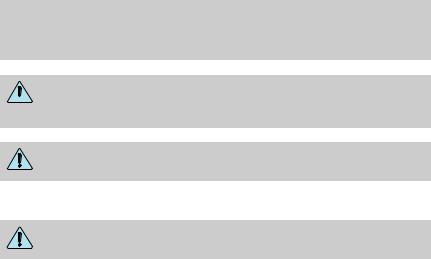
Introduction
Please read the section Supplemental restraint system (SRS)  in the Seating and Safety Restraints chapter. Failure to follow the specific warnings and instructions could result in personal injury.
in the Seating and Safety Restraints chapter. Failure to follow the specific warnings and instructions could result in personal injury.
Front seat mounted rear-facing child or infant seats should NEVER be placed in front of an active passenger air bag.
Notice to owners of pickup trucks and utility type vehicles
Utility vehicles have a significantly higher rollover rate than other types of vehicles.
Before you drive your vehicle, please read this Owner’s Guide carefully. Your vehicle is not a passenger car. As with other vehicles of this type, failure to operate this vehicle correctly may result in loss of vehicle control, vehicle rollover, personal injury or death.
Be sure to read Driving off road in the Driving chapter.
Using your vehicle with a snowplow
Do not use this vehicle for snowplowing.
Your vehicle is not equipped with a snowplowing package.
Using your vehicle as an ambulance
Do not use this vehicle as an ambulance.
Your vehicle is not equipped with the Ford Ambulance Preparation Package.
Middle East/North Africa vehicle specific information
For your particular global region, your vehicle may be equipped with features and options that are different from the ones that are described in this Owner’s Guide; therefore, a supplement has been supplied that complements this book. By referring to the pages in the provided supplement, you can properly identify those features, recommendations and specifications that are unique to your vehicle. Refer to this
Owner’s Guide for all other required information and warnings.
7
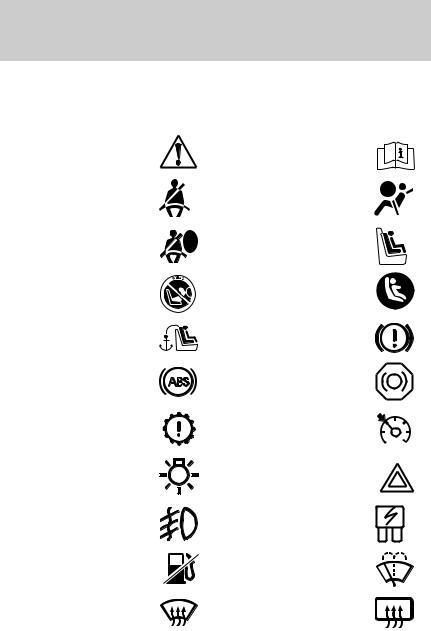
Introduction
These are some of the symbols you may see on your vehicle.
Vehicle Symbol Glossary |
||
Safety Alert |
See Owner’s Guide |
|
Fasten Safety Belt |
Air Bag-Front |
|
Air Bag-Side |
Child Seat |
|
Child Seat Installation |
Child Seat Lower |
|
Warning |
Anchor |
|
Child Seat Tether |
Brake System |
|
Anchor |
||
|
||
Anti-Lock Brake System |
Brake Fluid - |
|
Non-Petroleum Based |
||
|
||
Powertrain Malfunction |
Speed Control |
|
Master Lighting Switch |
Hazard Warning Flasher |
|
Fog Lamps-Front |
Fuse Compartment |
|
Fuel Pump Reset |
Windshield Wash/Wipe |
|
Windshield |
Rear Window |
|
Defrost/Demist |
Defrost/Demist |
|
8
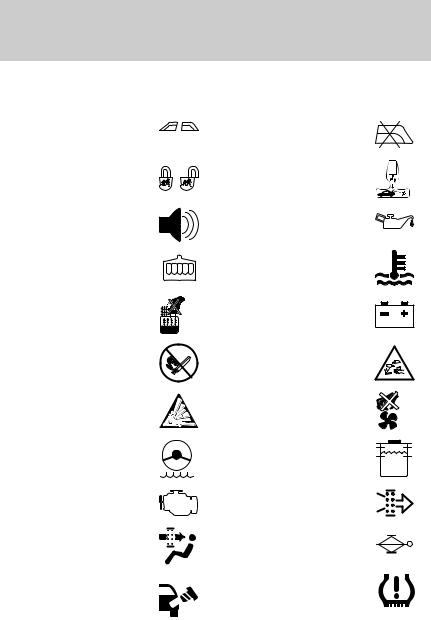
Introduction
Vehicle Symbol Glossary
Power Windows |
Power Window Lockout |
|
Front/Rear |
||
|
||
Child Safety Door |
Interior Luggage |
|
Compartment Release |
||
Lock/Unlock |
||
Symbol |
||
|
||
Panic Alarm |
Engine Oil |
|
Engine Coolant |
Engine Coolant |
|
Temperature |
||
|
||
Do Not Open When Hot |
Battery |
|
Avoid Smoking, Flames, |
Battery Acid |
|
or Sparks |
||
|
||
Explosive Gas |
Fan Warning |
|
Power Steering Fluid |
Maintain Correct Fluid |
|
Level |
||
|
||
Emission System |
Engine Air Filter |
|
Passenger Compartment |
Jack |
|
Air Filter |
||
|
||
Check fuel cap |
Low tire warning |
MAX
MIN
9
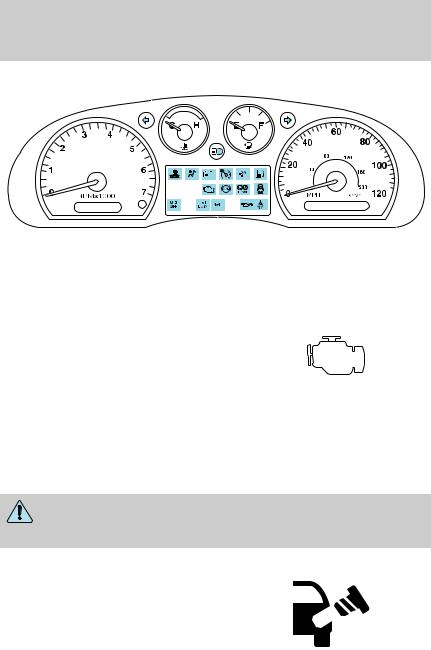
Instrument Cluster
WARNING LIGHTS AND CHIMES
Warning lights and gauges can alert you to a vehicle condition that may become serious enough to cause expensive repairs. A warning light may illuminate when a problem exists with one of your vehicle’s functions.
Many lights will illuminate when you start your vehicle to make sure the bulb works. If any light remains on after starting the vehicle, refer to the respective system warning light for additional information.
Check engine: The Check Engine indicator light illuminates when the ignition is first turned to the ON position to check the bulb. Solid
illumination after the engine is started indicates the On Board Diagnostics System (OBD-II) has detected a malfunction. Refer to On board diagnostics (OBD-II) in the Maintenance and Specifications chapter. If the light is blinking, engine misfire is occurring which could damage your catalytic converter. Drive in a moderate fashion (avoid heavy acceleration and deceleration) and have your vehicle serviced immediately.
Under engine misfire conditions, excessive exhaust temperatures could damage the catalytic converter, the fuel system, interior
floor coverings or other vehicle components, possibly causing a fire.
Check fuel cap: Illuminates when the fuel cap may not be properly installed. Continued driving with this light on may cause the Check Engine warning light to come on.
10
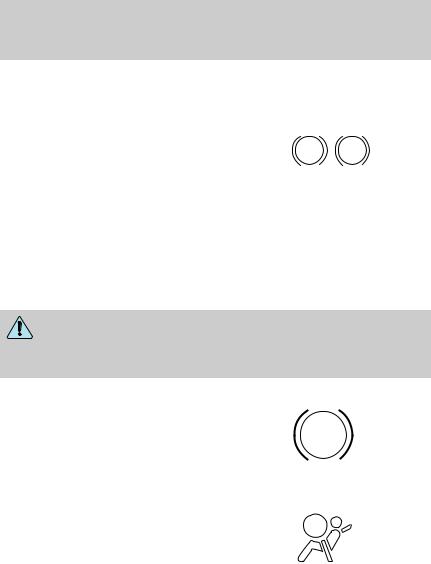
Instrument Cluster
It may take a long period of time for the system to detect an improperly installed or properly re-installed fuel filler cap depending on driving and fuel tank level conditions. Refer to Fuel filler cap in the Maintenance and Specifications chapter.
Brake system warning light: To |
! |
P |
confirm the brake system warning |
||
light is functional, it will |
BRAKE |
|
momentarily illuminate when the |
||
ignition is turned to the ON position
when the engine is not running, or in a position between ON and START, or by applying the parking brake when the ignition is turned to the ON position. If the brake system warning light does not illuminate at this time, seek service immediately from your dealership. Illumination after releasing the parking brake indicates low brake fluid level or a failure to brake proportioning and the brake system should be inspected immediately by your servicing dealership.
Driving a vehicle with the brake system warning light on is dangerous. A significant decrease in braking performance may
occur. It will take you longer to stop the vehicle. Have the vehicle checked by your dealer immediately.
Anti-lock brake system: If the
ABS light stays illuminated or ABS continues to flash, a malfunction has
been detected; have the system serviced immediately. Normal
braking is still functional unless the brake warning light also is illuminated.
Air bag readiness: If this light fails to illuminate when ignition is turned to ON, continues to flash or remains on, have the system serviced immediately. A chime will also
sound when a malfunction in the supplemental restraint system has been detected.
11
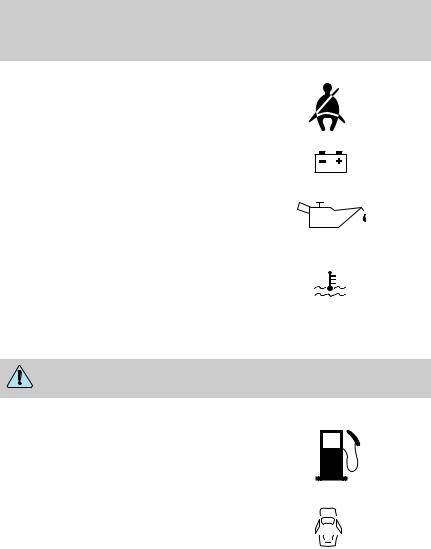
Instrument Cluster
Safety belt: Reminds you to fasten your safety belt. A chime will also sound to remind you to fasten your safety belt.
Charging system: Illuminates when the battery is not charging properly.
Engine oil pressure: Illuminates when the oil pressure falls below the normal range, refer to Engine oil in the Maintenance and Specifications chapter.
Engine coolant temperature (if equipped): Illuminates when the engine coolant temperature is high.
Stop the vehicle as soon as possible , switch off the engine and let cool. Refer to Engine coolant in the Maintenance and Specifications chapter.
Never remove the coolant reservoir cap while the engine is running or hot.
Low fuel: Illuminates when the fuel level in the fuel tank is at or near empty (refer to Fuel gauge in this chapter).
Door ajar: Illuminates when the ignition is in the ON position and any door is open.
Overdrive off (if equipped):
Illuminates when the overdrive function of the transmission has been turned off, refer to the
Driving chapter. If the light flashes steadily or does not illuminate, have the transmission serviced soon, or damage may occur.
12

|
Instrument Cluster |
|
Four wheel drive low (if |
4x4 |
|
equipped): Illuminates when |
||
LOW |
||
four-wheel drive low is engaged. |
||
Four wheel drive high (if |
4x4 |
|
equipped): Illuminates when |
|
four-wheel drive high is engaged. It
may also illuminate when the 4WD LOW is engaged, refer to the Driving chapter for more information.
Speed control: Illuminates when the speed control is engaged. Turns off when the speed control system is disengaged.
Turn signal: Illuminates when the left or right turn signal or the hazard lights are turned on. If the
indicators stay on or flash faster, check for a burned out bulb.
High beams: Illuminates when the high beam headlamps are turned on.
Key-in-ignition warning chime: Sounds when the key is left in the ignition in the OFF/LOCK or ACCESSORY position and the driver’s door is opened.
Headlamps on warning chime: Sounds when the headlamps or parking lamps are on, the ignition is off (the key is not in the ignition) and the driver’s door is opened.
Door ajar warning chime: Sounds when any door is opened (or not fully closed).
13
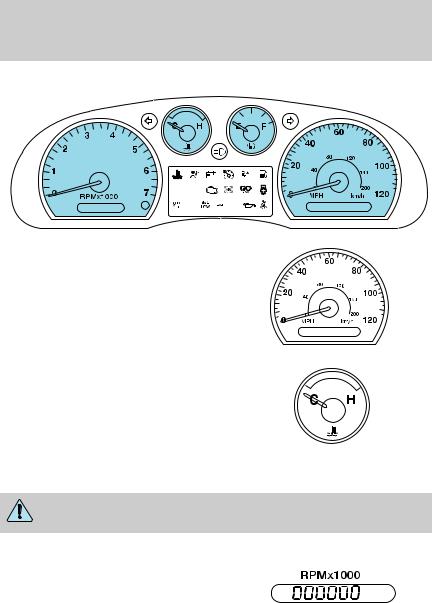
Instrument Cluster
GAUGES
Speedometer: Indicates the current vehicle speed.
Engine coolant temperature gauge: Indicates engine coolant temperature. At normal operating temperature, the needle will be in the normal range (between “H” and
“C”). If it enters the red section, the engine is overheating. Stop
the vehicle as soon as safely
possible, switch off the engine and let the engine cool.
Never remove the coolant reservoir cap while the engine is running or hot.
Odometer: Registers the total miles (kilometers) of the vehicle.
14
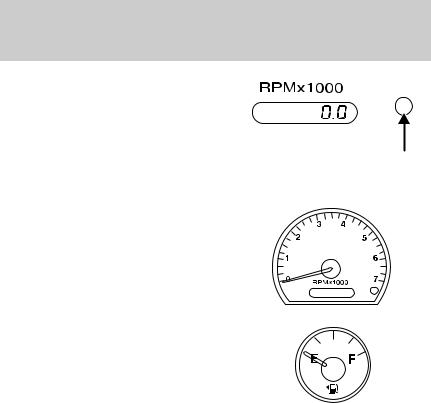
Instrument Cluster
Trip odometer: Registers the miles (kilometers) of individual journeys. Press the button once until “TRIP”
appears in the display (this represents the trip mode). To reset
the trip, press and hold the control again for approximately 2 seconds,
until the trip reading is 0.0 miles (kilometers). To toggle between trip and odometer, press and release the control.
Tachometer: Indicates the engine speed in revolutions per minute. Driving with your tachometer pointer continuously at the top of the scale may damage the engine.
Fuel gauge: Indicates approximately how much fuel is left in the fuel tank (when the ignition is in the ON position). The fuel gauge may vary slightly when the vehicle is in motion or on a grade.
Proper gauge indication requires the ignition to be in the OFF or
ACCESSORY position during refueling, otherwise correct fuel indication after refueling can be slow to update. Also, a minimum of 3 gallons is needed for correct indication after refueling.
The arrow near the fuel pump icon indicates which side of the vehicle the fuel filler door is located.
Refer to Filling the tank in the Maintenance and Specifications chapter for more information.
15
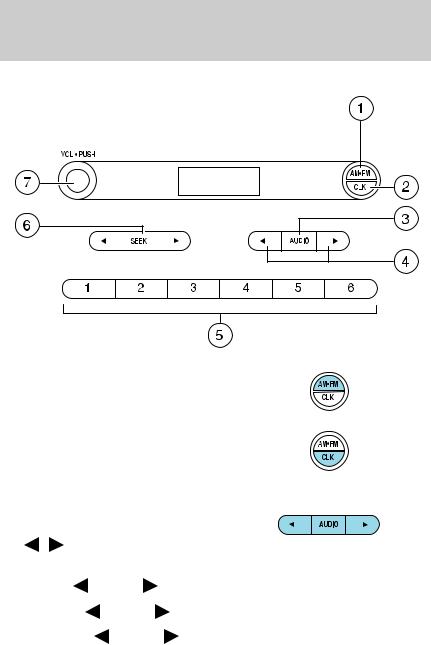
Entertainment Systems
AM/FM STEREO (IF EQUIPPED)
1. AM/FM: Press to select AM/FM1/FM2 frequency bands.
2. CLK: Press until SELECT HOUR
/ SELECT MINS appears. Press  AUDIO
AUDIO  to adjust the
to adjust the
hours/minutes.
Press CLK to display the time when the ignition is off.
3. AUDIO: Press AUDIO to toggle through the following modes and
use |
/ |
to make adjustments in |
||
those modes. |
|
|
||
Bass: Press |
|
AUDIO |
to decrease/increase the bass setting. |
|
Treble: Press |
AUDIO |
to decrease/increase the treble setting. |
||
Balance: Press |
AUDIO |
to adjust the audio between the left and |
||
right speakers. |
|
|
||
16
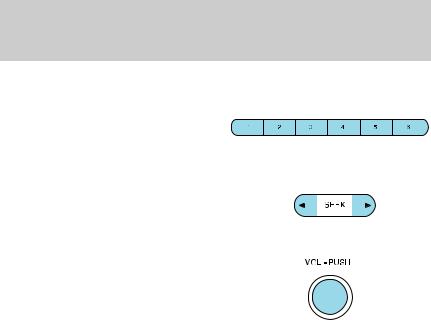
Entertainment Systems
4.Tune: Press to manually go down/up ( /
/ ) the radio frequency and in audio mode to select various settings.
) the radio frequency and in audio mode to select various settings.
5.Memory presets: To set a
station: Select frequency band AM/FM; tune to a station, press and
hold a preset button until sound returns. To tune a preset station, press the desired memory preset.
6. SEEK: Press  SEEK
SEEK  to
to
access the previous or next radio station. If pressed for less than .5
seconds, the system will seek to the next or previous station.
7. ON/OFF/Volume: Press to turn the system ON/OFF. Turn to adjust
the volume levels.
If the volume is set above a certain level, and the ignition is turned off, the volume will come back to a
“nominal” listening level when the ignition is turned back on.
17
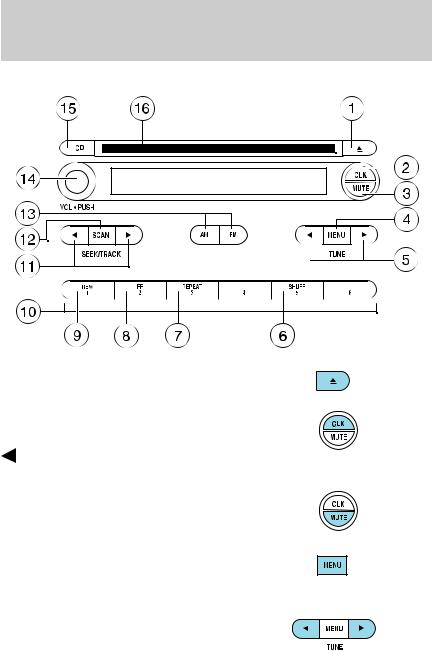
Entertainment Systems
AM/FM STEREO SINGLE CD/MP3 SYSTEM (IF EQUIPPED)
1. CD eject: Press to eject the CD.
2. CLK (Clock):Press CLK until
SELECT HOUR or SELECT MINS is displayed. Press
MENU  to adjust the
to adjust the
hours/minutes. Press CLK to display the time when the ignition is off.
3. MUTE:Press to mute the playing media. Press again to return to the playing media.
4. MENU: Press MENU repeatedly to toggle through the following
modes and use  /
/ to make adjustment in those modes.
to make adjustment in those modes.
Autoset: Press  MENU
MENU  to
to
set the strongest local radio stations for AM/FM1/FM2 without losing
18
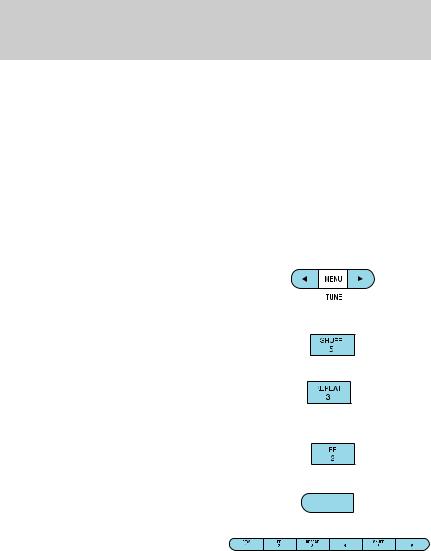
Entertainment Systems
your original manually set preset stations.
When the six strongest stations are filled, the station stored in preset 1 will begin playing. If there are less than six strong stations, the system will store the last one in the remaining presets.
Bass: Press  MENU
MENU  to decrease/increase the bass setting.
to decrease/increase the bass setting.
Treble: Press  MENU
MENU  to decrease/increase the treble setting.
to decrease/increase the treble setting.
Balance: Press  MENU
MENU  to adjust the audio between the left and right speakers.
to adjust the audio between the left and right speakers.
Fade: Press  MENU
MENU  to adjust the audio between the front and rear speakers.
to adjust the audio between the front and rear speakers.
5. TUNE: Press to manually go down/up ( /
/ ) the radio
) the radio
frequency and also to select various settings in menu mode.
6.SHUFF (Shuffle): Press to play the tracks on the current CD in random order.
7.REPEAT: Press to repeat the current CD track. The selection will repeat continuously until
deactivated. Press REPEAT again to deactivate.
8.FF (Fast forward): Press to
manually advance in a CD track.
9. REW (Rewind): Press to manually reverse in a CD track.
REW 1
10. Memory presets: To set a station: Select frequency band
AM/FM; tune to a station, press and
hold a preset button until sound returns. To recall a previously set station, press the desired memory preset button briefly.
11. SEEK/TRACK: Press to access the previous/next ( /
/ ) strong station. In CD mode, press to advance to the previous/next (
) strong station. In CD mode, press to advance to the previous/next ( /
/ ) track.
) track.
19

Entertainment Systems
12.SCAN: Press to toggle between SCAN ON and SCAN OFF. When activated, the system scans up
through and plays a brief sampling of available radio stations or CD tracks. Press again to stop.
13.AM/FM:Press to select
AM/FM1/FM2 frequency band.
14.ON/OFF/Volume: Press to turn ON/OFF. Turn to increase/decrease volume.
If the volume is set above a certain level and the ignition is turned off, the volume will come back on at a
“nominal” listening level when the ignition switch is turned back on.
15.CD: Press to enter CD mode. If
a CD is already present in the system, the disc will begin to play.
16. CD slot: Insert a CD label side up.
CD units are designed to play commercially pressed 4.75 in (12 cm) audio compact discs only. Due to technical incompatibility, certain recordable and re-recordable compact discs may not function correctly when used in Ford CD players. Irregular shaped CDs, CDs with a scratch protection film attached, and CDs with homemade paper (adhesive) labels should not be inserted into the CD player. The label may peel and cause the CD to become jammed. It is recommended that homemade CDs be identified with permanent felt tip marker rather than adhesive labels. Ballpoint pens may damage CDs. Please contact your dealer for further information.
20
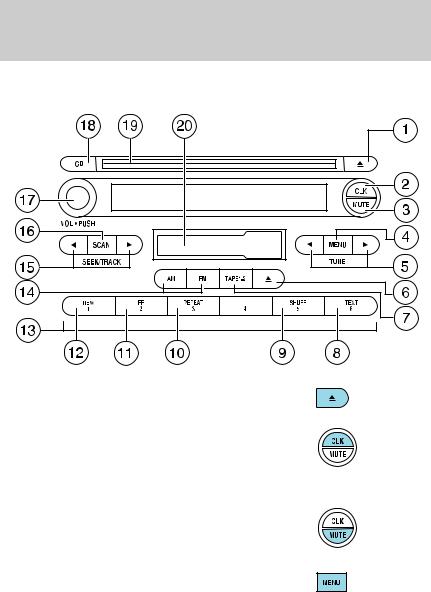
Entertainment Systems
AM/FM STEREO CASSETTE, CD/MP3 SOUND SYSTEM (IF EQUIPPED)
1. CD eject: Press to eject the CD.
2. CLK (Clock): Press CLK until
SELECT HOUR or SELECT MINS is displayed. Press  MENU
MENU  to
to
adjust the hours/minutes.
Press CLK to display the time of day when the ignition is off.
3. MUTE: Press to mute the playing media. Press again to return to the playing media.
4. MENU: Press MENU repeatedly to toggle through the following
modes and use  /
/ to make adjustment in those modes.
to make adjustment in those modes.
21
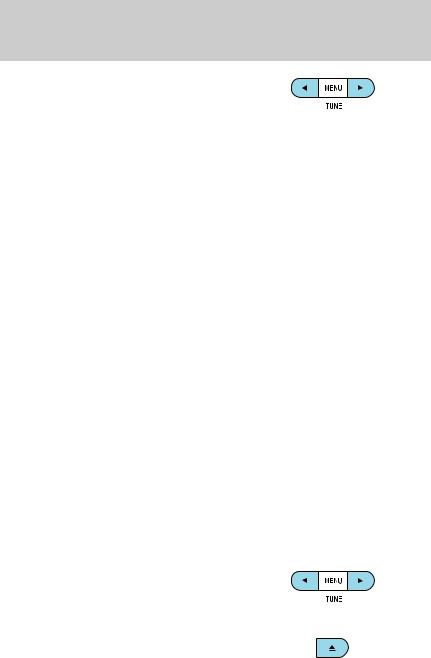
Entertainment Systems
Autoset: Press MENU to access the autoset setting. Allows you to set
the strongest local radio stations without losing your original
manually set preset stations for AM/FM1/FM2 . Use  MENU
MENU  to set.
to set.
When the six strongest stations are filled, the station stored in preset 1 will begin playing. If there are less than six strong stations, the system will store the last one in the remaining presets. Press again to disengage.
Bass: Press  MENU
MENU  to decrease/increase the level of bass.
to decrease/increase the level of bass.
Treble: Press  MENU
MENU  to decrease/increase the level of treble.
to decrease/increase the level of treble.
Balance: Press  MENU
MENU  to adjust the audio between the left and right speakers.
to adjust the audio between the left and right speakers.
Fade: Press  MENU
MENU  to adjust the audio between the front and rear speakers.
to adjust the audio between the front and rear speakers.
Next/previous directory: In MP3 mode, press  MENU
MENU  to go to the previous or next MP3 directory.
to go to the previous or next MP3 directory.
Flat file/directory mode: Press  MENU
MENU  to select Flat file mode or Directory mode.
to select Flat file mode or Directory mode.
Track number/music name/file name: In MP3 mode, press  MENU
MENU  to view by track number, music name or file name.
to view by track number, music name or file name.
Dolby:  Dolby noise reduction: Reduces tape noise and hiss. Press
Dolby noise reduction: Reduces tape noise and hiss. Press  MENU
MENU  to cycle Dolby ON/OFF. The Dolby noise
to cycle Dolby ON/OFF. The Dolby noise
reduction system is manufactured under license from Dolby Laboratories Licensing Corporation. Dolby and the double-D symbol are registered trademarks of Dolby Laboratories Licensing Corporation.
5. TUNE: Press to manually go down/up ( /
/ ) the radio
) the radio
frequency and also to select various settings in menu mode.
6. Tape eject: Press to eject the tape.
22
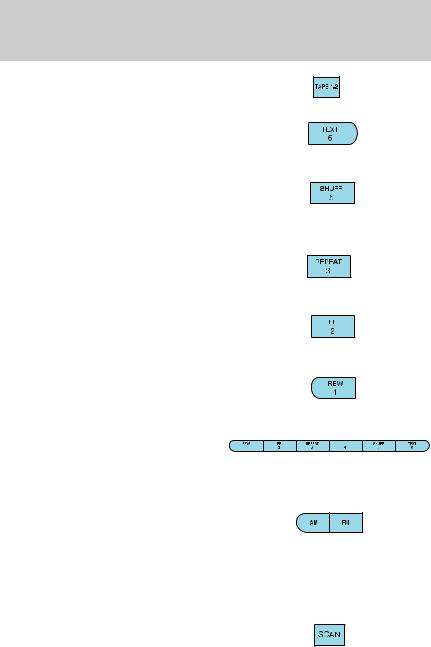
Entertainment Systems
7. Tape 1–2: Press to change playing sides of the tape.
8. TEXT: In MP3 mode, press to view the next 12 characters in the MP3 Music name/file name of the current MP3 track and directory.
9. SHUFF (Shuffle): In CD or MP3 mode, press to play the tracks on the current CD/MP3 in random
order. In MP3 directory mode, press to play the tracks within the current directory in random order.
10. REPEAT: Press to repeat the current CD/MP3 track. The selection will repeat continuously until
deactivated. Press REPEAT again to deactivate.
11. FF (Fast forward): In tape mode, press to fast forward the tape. In CD mode, press to manually advance in a CD track.
12. REW (Rewind): In tape mode, press to rewind the tape. In CD mode, press to manually reverse in a CD track.
13. Memory presets: To set a station: Select frequency band
AM/FM; tune to a station, press and
hold a preset button until sound returns. To select a preset station, press the desired memory preset button.
14.AM/FM: Press to select AM/FM1/FM2 frequency band.
15.SEEK/TRACK: In radio mode, press  /
/ to access the
to access the
previous/next strong station. In CD and MP3 flat file mode, press to access the next track. In MP3 directory mode, press to select the next/previous track in the current directory.
16. Scan: In radio mode, scan through the available stations. In tape mode, you may set SCAN on or
23
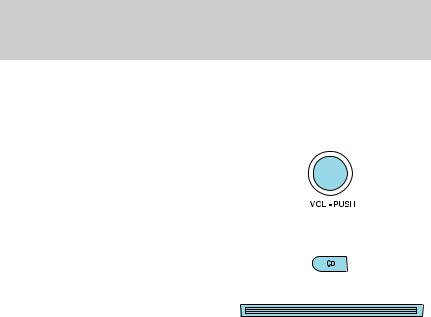
Entertainment Systems
off. If activated, the player will scan the tape and plays a short Introduction of each song. In CD and MP3 flat file mode, you may set the scan on or off. If activated, the system will scan through each track. In MP3 directory mode, you may set scan on or off. If activated, the system will scan in the current directory.
17.ON/OFF/Volume: Press to turn ON/OFF. Turn to increase/decrease volume.
If the volume is set above a certain level and the ignition is turned off, the volume will come back on at a
“nominal” listening level when the ignition switch is turned back on.
18.CD: Press to enter CD mode. If
a CD is already in the system, the disc will begin play.
19. CD slot: Insert a CD, label side up.
CD units are designed to play commercially pressed 4.75 in (12 cm) audio compact discs only. Due to technical incompatibility, certain recordable and re-recordable compact discs may not function correctly when used in Ford CD players. Irregular shaped CDs, CDs with a scratch protection film attached, and CDs with homemade paper (adhesive) labels should not be inserted into the CD player. The label may peel and cause the CD to become jammed. It is recommended that homemade CDs be identified with permanent felt tip marker rather than adhesive labels. Ballpoint pens may damage CDs. Please contact your dealer for further information.
20. Cassette slot: Insert a cassette, facing to the right.
24
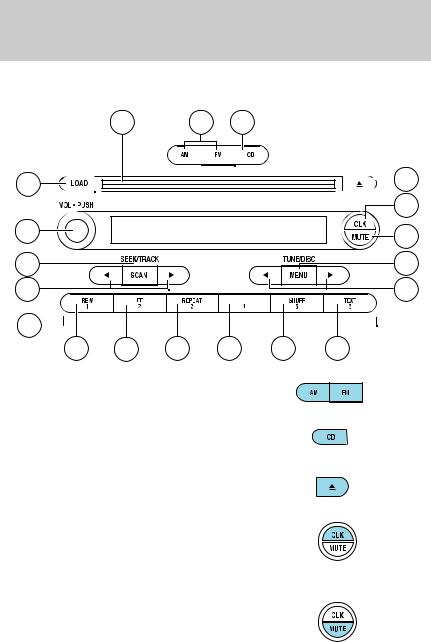
Entertainment Systems
PREMIUM/AUDIOPHILE IN-DASH CD6/MP3 DISC PIONEER AUDIO SYSTEM (IF EQUIPPED)
|
19 |
1 |
|
2 |
|
18 |
|
|
|
|
3 |
|
|
|
|
|
|
|
|
|
|
|
4 |
17 |
|
|
|
|
5 |
|
|
|
|
|
|
16 |
|
|
|
|
6 |
15 |
|
|
|
COMP |
7 |
|
|
|
|
|
|
14 |
|
|
|
|
|
13 |
12 |
11 |
10 |
9 |
8 |
1.AM/FM: Press to select AM/FM1/FM2 frequency bands.
2.CD: Press to enter CD mode. If a CD is already in the system, the disc will start playing.
3.EJ (CD eject): Press to eject the CD. Press and hold to eject all CDs.
4.CLK (Clock): Press CLK until SELECT HOUR or SELECT MINS is
displayed. Press  MENU
MENU to
to
adjust the hours/minutes. Press CLK
to display the time when the ignition is off.
5. MUTE: Press to mute the playing media. Press again to return to the playing media.
25
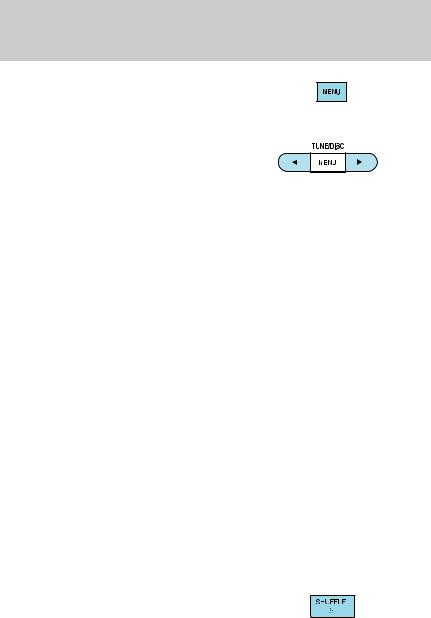
Entertainment Systems
6. MENU: Press MENU repeatedly to toggle through the following
modes and use  /
/ to make adjustment in those modes.
to make adjustment in those modes.
Autoset: Allows you to set the strongest local radio stations without losing your original
manually set preset stations for
AM/FM1/FM2 . Press MENU to access. Use  MENU
MENU  to set.
to set.
When the six strongest stations are filled, the station stored in preset 1 will begin playing. If there are less than six strong stations, the system will store the last one in the remaining presets.
Bass: Press  MENU
MENU to decrease/increase the bass setting.
to decrease/increase the bass setting.
Treble: Press  MENU
MENU to decrease/increase the treble setting.
to decrease/increase the treble setting.
Balance: Press  MENU
MENU to adjust the audio between the left and right speakers.
to adjust the audio between the left and right speakers.
Fade: Press  MENU
MENU to adjust the audio between the front and rear speakers.
to adjust the audio between the front and rear speakers.
Next/previous directory: In MP3 mode, press MENU  /
/ to go to the previous/next directory.
to go to the previous/next directory.
Flat file/directory mode: In MP3 mode, press MENU to access this feature. Use  MENU
MENU  to select flat file mode or directory mode.
to select flat file mode or directory mode.
Track #/normal music name/file name: Press MENU to access and use  /
/ to scroll through MP3 display options (track #, normal music name or file name).
to scroll through MP3 display options (track #, normal music name or file name).
7. TUNE/DISC: Press to manually go down/up ( /
/ ) the radio
) the radio
frequency, select the previous/next CD or to select various settings in menu mode.
8. TEXT: In MP3 music name/file name mode, press to view the next 12 characters in the MP3 music name/filename of the current MP3 track and directory.
9. SHUFF (Shuffle): Press to play the tracks on the current CD/MP3 in random order. In MP3 directory
mode, press to play the tracks within the current directory in random order.
26
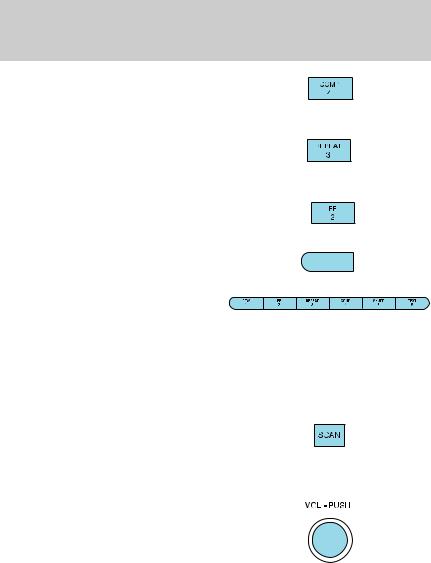
Entertainment Systems
10. Compression (Audiophile audios only): In CD/MP3 modes, press to bring loud and soft
passages together for a more consistent listening level.
11. REPEAT: Press to repeat the current CD/MP3 track. The selection will repeat continuously until
deactivated. Press REPEAT again to deactivate.
12.FF (Fast forward): Press to manually advance in a CD track.
13.REW (Rewind): Press to manually reverse in a CD track.
REW 1
14. Memory presets: To set a station: Select frequency band
AM/FM; tune to a station, press and
hold a preset button until sound returns. To select a preset station, press the desired memory preset.
15. SEEK/TRACK: In radio, CD and MP3 flat file mode, press  /
/
to access the previous/next strong station or track. In MP3 directory mode, press to select the next/previous track in the current directory.
16. SCAN: In radio, CD and MP3 flat file mode, press for a brief sampling of radio stations or
CD/MP3 tracks. In MP3 directory mode, press to hear a brief sampling of all tracks in the current directory. Press again to stop.
17. ON/OFF/Volume: Press to turn ON/OFF. Turn to increase/decrease
volume.
If the volume is set above a certain level and the ignition is turned off, the volume will come back on at a
“nominal” listening level when the ignition switch is turned back on.
18.LOAD: Press to load a CD. To load a CD/MP3 disc to a specific slot, press LOAD and select the slot number by pressing the memory preset buttons. Press and hold LOAD to autoload up to six discs.
19.CD slot: Insert a CD, label side up.
27
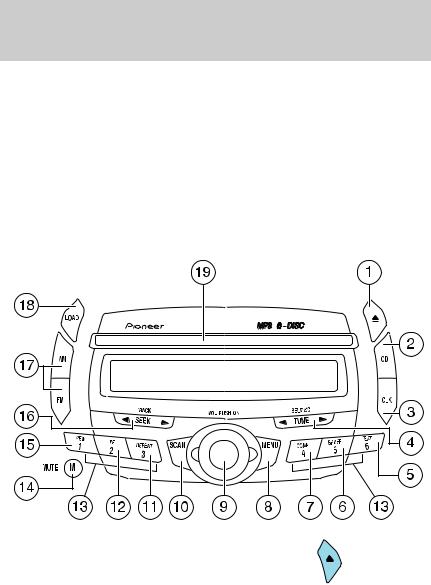
Entertainment Systems
CD units are designed to play commercially pressed 4.75 in (12 cm) audio compact discs only. Due to technical incompatibility, certain recordable and re-recordable compact discs may not function correctly when used in Ford CD players. Irregular shaped CDs, CDs with a scratch protection film attached, and CDs with homemade paper (adhesive) labels should not be inserted into the CD player. The label may peel and cause the CD to become jammed. It is recommended that homemade CDs be identified with permanent felt tip marker rather than adhesive labels. Ballpoint pens may damage CDs. Please contact your dealer for further information.
TREMOR IV CD/MP3 AUDIO SYSTEM (IF EQUIPPED)
1. EJ (CD eject): To eject an individual CD, press CD and select the correct slot number by pressing the Memory Preset buttons. Press and hold EJ (eject) to eject all loaded CDs.
28
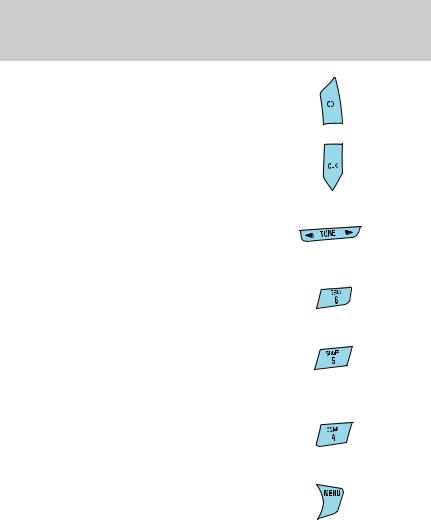
Entertainment Systems
2. CD: Press to enter CD mode. If a CD is already present in the system, the disc will begin play.
3. CLK (Clock): Press CLK until SELECT HOUR/SELECT MINUTE is
displayed. Press TUNE ( /
/ ) to
) to
adjust the hours/minutes.
Press CLK to display the time when the ignition is off.
4. TUNE: In radio mode, press to manually go up or down the radio frequency, or to access another CD.
Also use in menu mode to select various settings.
5. TEXT: In MP3 music name/file name mode, press to view the next 12 characters in the MP3 music
name/file name of the current MP3 track and directory.
6. SHUF (Shuffle): Press to play the tracks on the current CD/MP3 in random order. In MP3 directory
mode, press to play the tracks within the current directory in random order.
7. COMP (Compression): In CD/MP3 modes, press to bring soft and loud passages together for a more consistent listening level.
8. MENU: Press MENU to toggle through the following modes
and  TUNE
TUNE  to make adjustments in these modes.
to make adjustments in these modes.
Autoset: Allows you to set the strongest local radio stations without losing your original manually set preset stations for AM/FM1/FM2. Press
MENU to access, use  TUNE
TUNE  to set. When the six strongest
to set. When the six strongest
stations are filled, the station stored in preset 1 will begin playing. If there are less than six strong stations, the system will store the last one
in the remaining presets. Press  TUNE
TUNE  again to disengage.
again to disengage.
BASS: Press  TUNE
TUNE  to decrease/increase the bass levels.
to decrease/increase the bass levels.
29
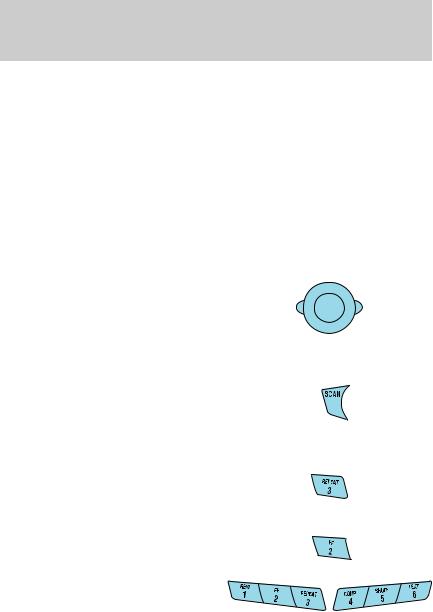
Entertainment Systems
TREB (treble): Press  TUNE
TUNE  to decrease/increase the treble levels.
to decrease/increase the treble levels.
BAL (Balance):Press  TUNE
TUNE  to adjust the audio between the left and right speakers.
to adjust the audio between the left and right speakers.
FADE: Press  TUNE
TUNE  to adjust the audio between the front and rear speakers.
to adjust the audio between the front and rear speakers.
Flat file/directory mode: In MP3 mode, press  TUNE
TUNE  to select Flat file mode or Directory mode.
to select Flat file mode or Directory mode.
Track number/normal music name/file name: Press  TUNE
TUNE  to view by track number, music name or file name.
to view by track number, music name or file name.
9. ON/OFF/VOL (Volume): Press to turn the system ON/OFF. Turn to adjust the volume levels.
If the volume is set above a certain level and the ignition is turned off,
the volume will come back on at a “nominal” listening level when the ignition is turned back on.
10. SCAN: In radio, CD and MP3 flat file mode, press for a brief sampling of radio stations or CD/MP3 tracks. In MP3 directory
mode, press to hear a brief sampling of all tracks in the current directory. Press again to stop.
11. REPEAT: Press to repeat the current CD/MP3 track. The selection will repeat continuously until
deactivated. Press REPEAT again to deactivate.
12. FF (fast forward): Press to manually advance in a CD track.
13. Memory presets: To set a
station: Select frequency band AM/FM; tune to a station, press and
hold a preset button until sound
returns. To select a preset station, press the desired memory preset button.
30
